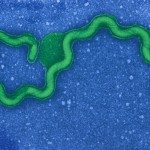Lien vers Pubmed [PMID] – 37662012
Lien DOI – 10.3389/fcimb.2023.1236866
Front Cell Infect Microbiol 2023 ; 13(): 1236866
Leptospirosis is a bacterial zoonotic disease. Humans and dogs are susceptible hosts, with similar clinical manifestations ranging from a febrile phase to multiple organ dysfunction. The incidence of leptospirosis in mainland France is relatively high, at about 1 case per 100,000 inhabitants, but our knowledge of the strains circulating in humans and dogs remains limited. We studied the polymorphism of the lfb1 gene sequences in an exhaustive database, to facilitate the identification of Leptospira strains. We identified 46 species-groups (SG) encompassing the eight pathogenic species of Leptospira. We sequenced the lfb1 gene amplification products from 170 biological samples collected from 2019 to 2021: 110 from humans and 60 from dogs. Epidemiological data, including vaccination status in dogs, were also collected. Three Leptospira species displaying considerable diversity were identified: L. interrogans, with eight lfb1 species-groups (including five new lfb1 species-groups) in humans and dogs; L. kirschneri, with two lfb1 species-groups in humans and dogs; and L. borgpetersenii, with one lfb1 species-group in humans only. The lfb1 species-group L. interrogans SG1, corresponding to serovar Icterohaemorrhagiae or Copenhageni, was frequently retrieved from both humans and dogs (n=67/110; 60.9% and n=59/60; 98.3% respectively). A high proportion of the affected dogs developed the disease despite vaccination (n=30/60; 50%). Genotyping with the polymorphic lfb1 gene is both robust and simple. This approach provided the first global picture of the Leptospira strains responsible for acute infections in mainland France, based on biological samples but without the need for culture. Identification of the Leptospira strains circulating and their changes over time will facilitate more precise epidemiological monitoring of susceptible and reservoir species. It should also facilitate the monitoring of environmental contamination, making it possible to implement preventive measures and to reduce the burden of this disease.




